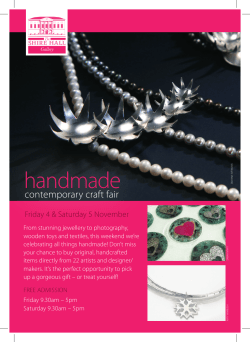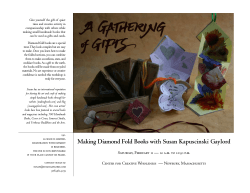
Card Flowers by Fence on Handmade Paper The Product
Card Flowers by Fence on Handmade Paper The Product Handmade paper from the Philippines is commonly made from cogon grass. An invasive weed, cogon grass – also known as imperata cylindrica – overtakes fields with a dense mat of thatch, leaving it nearly impossible for other plants to grow. As such, making use of this unruly weed by mixing it with other natural fibres such as abaca, rice stalks, pineapple leaves, and salago bark, is an environmentally-friendly way to produce paper products. After purchasing the cogon grass from local farmers, Salay artisans chop the material into small pieces and then boil it in caustic soda and water. Since “good water makes good paper,” they pump spring water (easily accessed by villagers) into tanks during the night. The fibres are then washed three times, beaten, and blended until the pulp achieves the desired texture; more washings follow, together with bleach. Waste water from this process is collected in tanks, aerated until it is clear, and reused. Although papermaking produces minimal pollution, Loreta Rafisura has insisted that SHAPII’s operations not harm the environment. With the help of a grant from Ten Thousand Villages Canada, she was able to develop a wastewater management system that treats water used in production for reuse. Through this new system, the clean water is released into a small fish pond where, as long as the fish are thriving, the water is once again safe for general use. This way, Loreta says proudly, “we are giving livelihood to our people with one hand and not doing any harm with the other.” Card Flowers by Fence on Handmade Paper Travel the world with each visit to Ten Thousand Villages. Learn how Fair Trade really makes a difference. Our goal is to provide vital, fair income to artisans by marketing their handicrafts and telling their stories in North America. Ten Thousand Villages sells product from more than 30 countries, providing work for nearly 60,000 people around the world. Once the pulp has been floated in a large vat of water, artisans lower hand-held screens into the tub, lifting them once an even, thin sheet of paper has formed. Some types of paper are made by floating leaves and flowers petals in the pulp. After these have been added and a large pressing machine has squeezed out the excess water, the paper sheet is then transferred to a steel plate to dry in the hot sun. Once it has been carefully peeled off, the sheet goes to the cutting room where it is “calendared” to make it smooth and then cut to specific dimensions. Two shifts of artisans at Salay make the actual paper, while others create a range of distinctive finished products. Now the decorating begins; housewives and out-of-school youths carefully arrange delicate flower petals, leaves, and twigs in intricate designs using tiny scissors, tweezers, and magnifying glasses. While flowers grow in abundance around the village of Salay, to ensure continued availability, every artisan has a flower garden and the cooperative holds an annual garden contest! Through this painstaking process, a mangy, uncooperative weed is transformed into an array of unique paper gifts such as cards, boxes, picture frames, lamps, and other lovely items. The Artisan Group: Salay Handmade Paper Salay Handmade Paper was founded in the late 1980s by Loreta Rafisura, a nurse turned entrepreneur and her husband, Dr. Reynaldo, who aimed to transform the lives of people in their community of Salay, on the island of Mindanao. Beginning as a civic organization known as People's Economic Council (PEC), ten local supporters helped found the NGO to create employment for people in an area with little industry and a history of political unrest. Through experimentation, the group developed its trademark handmade paper using cogon grass, a weed that interferes with local farming. In 1990, the papermakers incorporated separately from PEC as Salay Handmade Paper Industries, Inc. (SHAPII). Through global marketing, Salay was introduced to the concept of Fair Trade and began providing development assistance to its artisans – 70 percent of whom are women. The business has grown to over 300 co-op workers and several hundred other artisans making cards in their homes. Besides monthly pay and pensions, workers with Salay share in the profits, receiving regular dividends. Ninety percent of Salay products are exported to Fair Trade customers while 10 percent are sold domestically. The social arm of Salay, called SHAPII, is a multipurpose cooperative with 147 members involved in a wide range of economic development projects and providing school scholarships, medical aid, and classes in computer skills and English language literacy. Salay won the first Outstanding Small and Medium Enterprise Award in the small enterprise category manufacturing sector, sponsored by the Small and Medium Enterprise Council and Department of Trade and Industry of the Philippines. Salay is a member of the World Fair Trade Organization (WFTO). Meet An Artisan: Loreta Rafisura Loreta Rafisura: Within the sleepy coastal town of Salay in the southern Philippines runs a current of hope that is quietly – yet demonstrably – transforming the community. Through the vision and determination of one woman, the once war-ravaged and impoverished town is experiencing unprecedented growth. Loreta Rafisura, 67, has lived in the small fishing town most of her life. With 10 brothers and sisters, she felt the pressures of poverty. She had always wanted to be a doctor but studied nursing in Manila because her family could not afford medical school. A few years later, Loreta participated in a twoyear travel-nursing stint in the United States. Here, her "eyes were opened to the whole world,” she said. “I had such a great experience meeting people of different cultures.” Loreta’s experience also made her realize how impoverished Salay was. Back to Salay she went, where she met her husband, a doctor. Together, they worked to provide public health services to the community during the 1980s when the insurgent group in Mindanao, the New People's Army (NPA), staged a rebellion that displaced and injured many residents. “It was very difficult. During this time, people came to our house begging for food. It really touched our hearts and we wanted to do anything we could to help,” she said. At that time, Loreta had been battling cancer and underwent a mastectomy. She used her recovery time to study the community and work with government agencies to build a plan for sustainable development. In a remote town with little industry, the task was a challenge. The secret? A mangy, uncooperative weed. To rebuild the community, Loreta and her husband didn’t need to look beyond their own backyard. Cogon grass, dubbed the “enemy of the farmers” because of its weed-like qualities, could be harvested to make a functional product: handmade paper. By leveraging farming know-how, the Rafisuras taught unemployed community members to use local plants and flowers to make paper. The organization, comprised of a mere 10 people, was named SHAPII – Salay Handmade Paper Industries, Inc. With limitless patience, the SHAPII team tried using salago bark, abaca bark, pineapple fibres, and banana leaves to create paper. In order to build business capacity, Loreta traveled around the world to learn about the multicultural uses of handmade paper. Loreta’s vision for SHAPII is centered on holistic development. Even its flag, equal parts blue and pink with a strip of green through the middle, represents gender equality and environmental responsibility. Working at SHAPII creates a positive identity for the community, said Loreta. “Our members take pride in being Filipino and creating beautiful things.” SHAPII impacts about 10 percent of the population of Salay. Loreta says that many have found a major boost in confidence through their work at SHAPII, especially women. “Women have improved their self esteem by 200 percent,” said Loreta “They are prouder, more beautiful because they can now work.” The Country: Philippines Lying east of Vietnam, the Philippines constitutes an archipelago of more than 7000 islands, with roughly two-thirds of the country’s 89,468,677 residents living on the island of Luzon. Past Muslim, Spanish and American rule have resulted in an eclectic blend of native elements and foreign influences. Geography has also generated a multiplicity of languages, some 80 dialects in total. Once one of the richest countries in Asia, the Philippines has gradually become one of the poorest in the region since gaining independence in 1946. Light industry and services, however, have made considerable inroads in this mainly agricultural country as of late. Numerous call centers and business process outsourcing (BPO) firms have migrated to the Philippines, generating thousands of jobs. In spite of recent advances, poverty remains widespread in the Philippines, with 30 percent living below the national poverty line. The economy is heavily dependent on money sent home by millions of Filipinos working overseas and, despite government attempts to tackle problems, the gap between rich and poor is widening. With countries like China offering cheap product to the world, handicraft artisans are finding it increasingly difficult to compete in the export market.
© Copyright 2025









